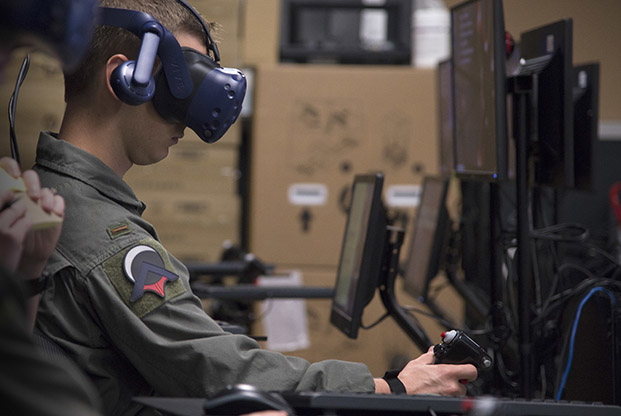
USAF 2nd Lt. Austin Sneed, Pilot Training Next student, trains on a virtual reality flight simulator at the Armed Forces Reserve Center in Austin, Texas, on June 18, 2018. Air Force photo by Sean Worrell.
The Air Force is hoping to improve the capabilities of the artificial intelligence coach in the second Pilot Training Next class, which will launch in the next few weeks.
Pilot Training Next is a collaborative effort between Air Education and Training Command and AFWERX—the Air Force’s innovation hub. The goal is to find more efficient ways to train the next generation of pilots.
In the initial beta test, the AI coach was always watching what the students were doing and how they learned, and it offered real-time advice to help them do things better. For example, if a student pilot needed to fly a loop, the AI coach would know if they were pulling too hard on the stick and could tell them to ease up. The AI coach also was able to figure out if a student is more of a visual learner or if the student prefers reading about a task first, and it can then personalize the training syllabus for that student.
Twenty students—15 officers and five enlisted airmen—participated in the first version of Pilot Training Next. Thirteen pilots graduated in half the time it normally takes to complete USAF’s Air Force Specialized Undergraduate Pilot Training course.
It is anticipated that the second version, which will kick off in late January, will have 24 students, possibly including one Navy pilot from the United Kingdom, AFWERX Mission Lead Beam Maue told Air Force Magazine.
In October 2018, AFWERX launched an open challenge for the second phase of the program, promising to spend up to $300,000 “for the right set of upgrades and solution trials” and noting the program “has the potential to reach $100 million or more in contracts over time.”
In round two, the service hopes to incorporate an AI tutor that “rapidly adapts to accomplished learning objectives,” according to the October challenge.
“Pilot Training Next previously utilized AI as a tutor that provided game-changing elements of individualized training. However, the current AI could not keep pace with student progress,” stated the challenge.
Maue said there are three basic areas the service is trying to advance with PTN2:
-
Better structure data as it comes off the pods so the AI coach can come up with a better syllabus the next time a student gets in a simulator.
-
Improve the biometric sensors students use during training. The first version used eye tracing software algorithms and hardware inside of virtual reality goggles, which traced a student’s eye movements and helped the AI coach determine whether or not he had really mastered a maneuver. This time around, Maue said AFWERX is looking at incorporating headbands that could provide different temperature, perspiration, and heart rate readings, to help determine a student’s stress level.
-
Improve the machine learning algorithms.
“AFWERX engages in experiments, and AETC has been a forward-leaning command with this experimental mindset as well,” Maue said. “So, going forward into any of these experiments, we wouldn’t expect we would have 100 percent of the technology identified for something that’s never been tried before.”
AFWERX received 150 different submissions in response to its October challenge to help advance pilot training. They selected 15 submitters to come to the AFWERX Austin storefront in December and give their pitch. From there, five business concepts were selected, and each submitter was awarded $50,000 to further refine their concept.
“When they come back with their results, they will be re-evaluated to see whether or not we can do some form of other transaction authority, prototyping contracts to further advance that type of technology,” Maue said.